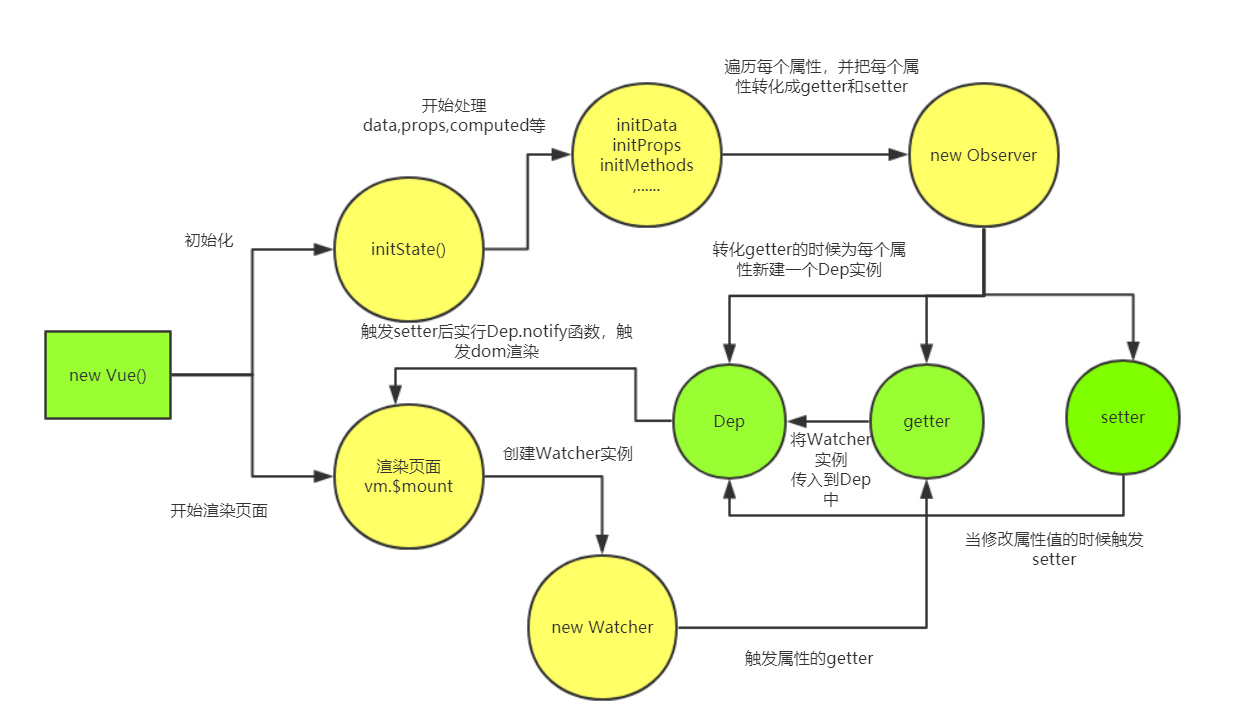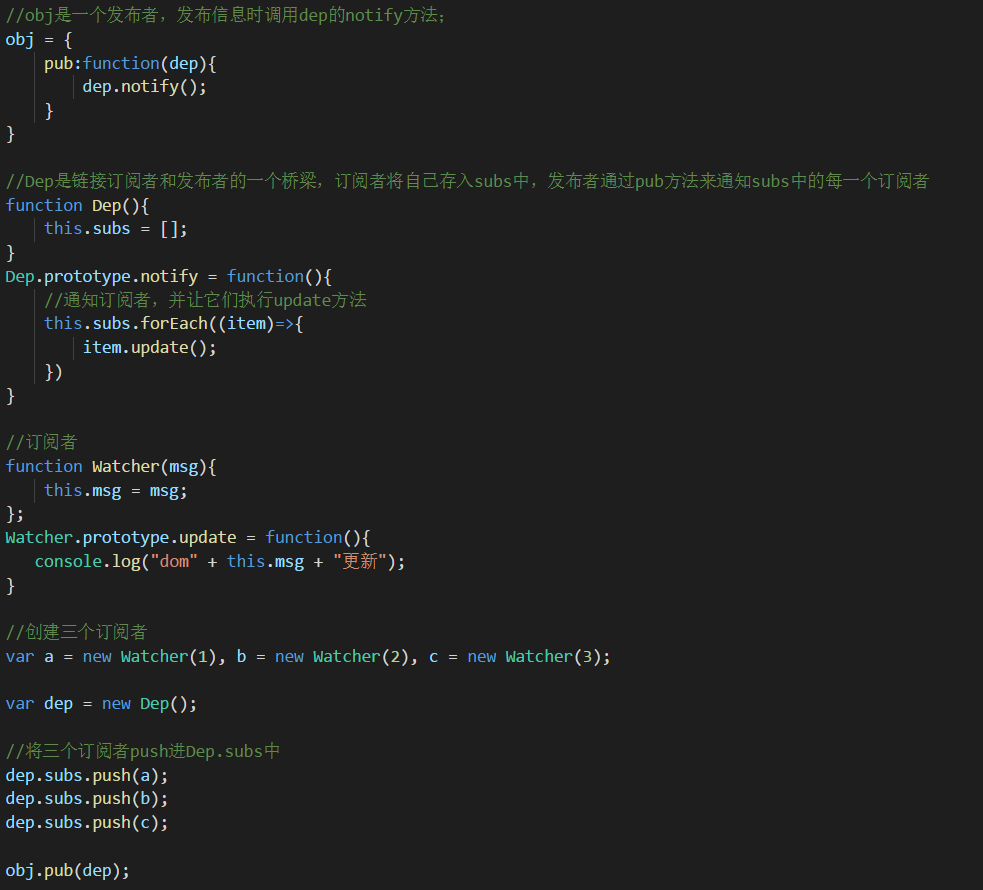从去年开始学习vue到今天有半年多的时间了,大部分功能也已经用的很熟练,所以是时候开始学习源码修炼修炼内功了,我会把自己学到看到的内容用最容易理解方式与大家分享,一起进步,如果文章有哪些不对的地方也欢迎大家指正。
老规矩,先放一张自己整理的图:
vue版本:2.5.0

一.准备
在分析源码之前,我先说两个关于数据绑定相关的知识点:
1. 对象的访问器属性——getter和setter:
Object有一个名为defineProperty的方法,可以设置访问器属性,比如:

当我们执行obj.a的时候会触发get函数,控制台会打印'this is the getter',当我们为obj.a赋值的时候,obj.a=2;这是控制台会打印"change new value"
大家可以把getter和setter理解成获取对象属性值和给对象属性赋值时的钩子就可以了。
2. 订阅者模式:
订阅者模式也叫“订阅-发布者模式”,对于前端来说这种模式简直无处不在,比如我们常用的xx.addEventListener('click',cb,false)就是一个订阅者,它订阅了click事件,当在页面触发时,浏览器会作为发布者告诉你,可以执行click的回调函数cb了。
再举一个更简单的例子,士兵与长官就是一个订阅与发布者的关系,士兵的所有行动都通过长官来发布,只有长官发号施令,士兵们才能执行对应的行动。

在这段代码中,obj是发布者,Watcher实例是订阅者,Dep用来储存订阅者,以及接受发布者通知的一个媒介。
另外,关于数据绑定还有一个知识点,那就是虚拟dom(vnode),不过鉴于这部分东西太多,我就在文中一笔带过了,今后会专门开一篇文章聊一聊vnode相关的内容。
二. 从data看数据绑定
1. 在vue/src/core/instance/index.js中:
function Vue (options) {
//options就是我们传入new Vue中的el,data,props,methods等
if (process.env.NODE_ENV !== 'production' &&
!(this instanceof Vue)
) {
warn('Vue is a constructor and should be called with the `new` keyword')
}
this._init(options)
}
这段代码是我们执行new Vue()时执行的函数,它先判断是否是使用new Vue()而不是Vue()创建实例,否则会有提示。接下来执行函数this._init(options);
2. 在vue/src/core/instance/init.js中的initMixin函数定义了vue._init()方法,需要关注的重点是这里:
Vue.prototype._init = function (options?: Object) {
const vm: Component = this;
......
initLifecycle(vm)
initEvents(vm)
initRender(vm)
callHook(vm, 'beforeCreate')
initInjections(vm)
initState(vm) //初始化data、props等数据的监听
initProvide(vm)
callHook(vm, 'created')
......
if (vm.$options.el) {
//渲染页面
vm.$mount(vm.$options.el)
}
}前半部分代码是初始化各种东西,包括生命周期,事件,数据等。后半部分代码vm.$mount(vm.$options.el)是用来渲染页面的。
这里我们先说最重要的initState(vm);
3. 在vue/src/core/instance/state.js中:
export function initState (vm: Component) {
vm._watchers = []
const opts = vm.$options; //opts就是options,即包含了el,data,props等属性或方法的对象
if (opts.props) initProps(vm, opts.props); //初始化props
if (opts.methods) initMethods(vm, opts.methods); //初始化methods
if (opts.data) {
initData(vm) //初始化data
} else {
observe(vm._data = {}, true /* asRootData */)
}
if (opts.computed) initComputed(vm, opts.computed)
if (opts.watch && opts.watch !== nativeWatch) {
initWatch(vm, opts.watch)
}
}
无论是props,data还是computed,属性绑定的思路都是差不多的,所以我就用data来说明了。
4. 在与initState相同的文件下,我们可以看到initData方法:
function initData (vm: Component) {
let data = vm.$options.data
//为data和vm._data赋值
data = vm._data = typeof data === 'function'
//如果data是函数,我们就将data的返回值挂载到vm下,赋给data和vm._data
? getData(data, vm)
: data || {}
if (!isPlainObject(data)) {
data = {}
process.env.NODE_ENV !== 'production' && warn(
'data functions should return an object:\n' +
'https://vuejs.org/v2/guide/components.html#data-Must-Be-a-Function',
vm
)
}
// proxy data on instance
const keys = Object.keys(data) //keys为data的属性组成的数组
const props = vm.$options.props
const methods = vm.$options.methods
let i = keys.length
while (i--) {
//这个循环里是判断是否出现data的属性与props,methods重名,否则给出警告
const key = keys[i]
if (process.env.NODE_ENV !== 'production') {
if (methods && hasOwn(methods, key)) {
warn(
`Method "${key}" has already been defined as a data property.`,
vm
)
}
}
if (props && hasOwn(props, key)) {
process.env.NODE_ENV !== 'production' && warn(
`The data property "${key}" is already declared as a prop. ` +
`Use prop default value instead.`,
vm
)
} else if (!isReserved(key)) {
proxy(vm, `_data`, key)
}
}
// observer方法,创建并返回Observer实例,实现绑定的重要函数
observe(data, true /* asRootData */)
}
5. 在vue/src/core/observer/index.js文件中,可以看到observer函数:
export function observe (value: any, asRootData: ?boolean): Observer | void {
if (!isObject(value) || value instanceof VNode) {
return
}
let ob: Observer | void
//如果传入的data有__ob__方法,直接复制给ob
if (hasOwn(value, '__ob__') && value.__ob__ instanceof Observer) {
ob = value.__ob__
} else if (
observerState.shouldConvert &&
!isServerRendering() &&
(Array.isArray(value) || isPlainObject(value)) &&
Object.isExtensible(value) &&
!value._isVue
) {
//否则通过new Observer(value)方法创建一个实例,并赋值给ob
ob = new Observer(value)
}
if (asRootData && ob) {
ob.vmCount++
}
return ob
}
6. 在同文件下可以看到Observer类的定义:
export class Observer {
value: any;
dep: Dep;
vmCount: number; // number of vms that has this object as root $data
constructor (value: any) {
this.value = value
this.dep = new Dep()
this.vmCount = 0
//为传入的data对象添加一个__ob__属性,值为Observer实例本身
def(value, '__ob__', this)
if (Array.isArray(value)) {
const augment = hasProto
? protoAugment
: copyAugment
//如果传入的data是个数组,执行augment()方法
augment(value, arrayMethods, arrayKeys)
this.observeArray(value)
} else {
//否则运行walk()方法,事实上大部分情况我们都走walk这个方法
this.walk(value)
}
}
7. 同文件下有walk函数:
在看代码之前我先插一句,这里传入的obj已经不是完整的data了,假设我们的data是这样的:
data(){
return {
a:1,
b:2,
}
}那么在经历了initData中的getData后,已经变成了{a:1, b:2};
好的我们接着说walk方法:
walk (obj: Object) {
const keys = Object.keys(obj)
for (let i = 0; i < keys.length; i++) {
defineReactive(obj, keys[i], obj[keys[i]])
}
}walk()方法遍历对象的每一个属性,执行defineReactive()方法,这个方法的作用就是将每个属性转化为getter和setter,同时新建一个Dep的实例。
8. 在和walk,Observer同文件下:
export function defineReactive (
obj: Object,
key: string,
val: any,
customSetter?: ?Function,
shallow?: boolean
) {
//每个属性偶读新建一个Dep的实例
const dep = new Dep()
//获取每个属性的特性:configurable、enumerable,getter,setter等等.......
const property = Object.getOwnPropertyDescriptor(obj, key)
if (property && property.configurable === false) {
return
}
// cater for pre-defined getter/setters
const getter = property && property.get
const setter = property && property.set
//这里是递归遍历属性值,有的属性的值还是对象,就继续执行observer
let childOb = !shallow && observe(val)
//重点!!将属性转化为getter,setter
Object.defineProperty(obj, key, {
enumerable: true,
configurable: true,
get: function reactiveGetter () {
const value = getter ? getter.call(obj) : val
if (Dep.target) {
dep.depend()
if (childOb) {
childOb.dep.depend()
if (Array.isArray(value)) {
dependArray(value)
}
}
}
return value
},
set: function reactiveSetter (newVal) {
const value = getter ? getter.call(obj) : val
/* eslint-disable no-self-compare */
if (newVal === value || (newVal !== newVal && value !== value)) {
return
}
/* eslint-enable no-self-compare */
if (process.env.NODE_ENV !== 'production' && customSetter) {
customSetter()
}
if (setter) {
setter.call(obj, newVal)
} else {
val = newVal
}
childOb = !shallow && observe(newVal)
dep.notify()
}
})
}
如果看了前面文章还有印象的话,相信大家在这段代码里会看到一位老朋友,没错,他就是在订阅者模式时提到的Dep。
在getter时执行了reactiveGetter函数,里面会判断Dep.target是否存在,如果存在,则执行dep.depend()方法;而在setter的最后,执行了dep.notify()方法。
三. Dep类
在vue/src/core/observer/dep.js中我们可以看到Dep类的定义:
export default class Dep {
static target: ?Watcher;
id: number;
subs: Array<Watcher>;
constructor () {
this.id = uid++
this.subs = []
}
//将订阅者添加到this.subs中
addSub (sub: Watcher) {
this.subs.push(sub)
}
removeSub (sub: Watcher) {
remove(this.subs, sub)
}
//defineReactive方法中使用的depend方法
depend () {
if (Dep.target) {
Dep.target.addDep(this)
}
}
//通知订阅者执行update()函数
notify () {
// stabilize the subscriber list first
const subs = this.subs.slice()
for (let i = 0, l = subs.length; i < l; i++) {
subs[i].update()
}
}
}
看到this.subs和notify()相信你已经知道Dep是什么了吧?没错,就如同我前面讲的,Dep这个类就是在vue实现数据绑定的过程中,作为订阅者和发布者的一个桥梁。通过defineReactive的代码我们可以知道,当为属性赋值触发setter时会执行dep.notify(),我们可以说set函数执行了发布者的行为,那订阅者又是谁呢?Dep.target又是什么呢?我们继续往下看。
四. 订阅者Watcher
我们继续看dep.js这个文件,在文件最后几行,有如下代码:
Dep.target = null
const targetStack = []
export function pushTarget (_target: Watcher) {
if (Dep.target) targetStack.push(Dep.target)
Dep.target = _target
}
export function popTarget () {
Dep.target = targetStack.pop()
}pushTarget()方法就是把传入的Watcher实例赋给Dep.target,一旦Dep.target有值的话,就可以执行dep.depend()方法了。
我们在vue/src/core/obsever/watcher.js可以看到Watcher类的定义:
export default class Watcher {
.......
constructor (
vm: Component, //vm
expOrFn: string | Function,
cb: Function,
options?: Object
) {
this.vm = vm
vm._watchers.push(this)
// options
if (options) {
this.deep = !!options.deep
this.user = !!options.user
this.lazy = !!options.lazy
this.sync = !!options.sync
} else {
this.deep = this.user = this.lazy = this.sync = false
}
this.cb = cb
this.id = ++uid // uid for batching
this.active = true
this.dirty = this.lazy // for lazy watchers
this.deps = []
this.newDeps = []
this.depIds = new Set()
this.newDepIds = new Set()
this.expression = process.env.NODE_ENV !== 'production'
? expOrFn.toString()
: ''
// parse expression for getter
//如果Watcher第二个参数是函数,就赋值给this.getter
if (typeof expOrFn === 'function') {
this.getter = expOrFn
} else {
this.getter = parsePath(expOrFn)
if (!this.getter) {
this.getter = function () {}
process.env.NODE_ENV !== 'production' && warn(
`Failed watching path: "${expOrFn}" ` +
'Watcher only accepts simple dot-delimited paths. ' +
'For full control, use a function instead.',
vm
)
}
}
this.value = this.lazy
? undefined
//大部分情况下不会传options参数,this.lazy值为false,所以执行this.get()方法
: this.get()
}
Watcher下方就有get()方法的定义:
get () {
//先将Watcher实例赋值给Dep.target;
pushTarget(this)
let value
const vm = this.vm
try {
//执行this.getter方法
value = this.getter.call(vm, vm)
} catch (e) {
if (this.user) {
handleError(e, vm, `getter for watcher "${this.expression}"`)
} else {
throw e
}
} finally {
// "touch" every property so they are all tracked as
// dependencies for deep watching
if (this.deep) {
traverse(value)
}
popTarget()
this.cleanupDeps()
}
return value
}
get方法先给Dep.Target赋值,接着执行this.getter()方法。那么什么时候新建Watcher实例?给Dep.target赋值呢?
在回答这个问题前我先说一下dep.depend方法,里面执行了Dep.target.addDep(this),这个方法也可以换成new Watcher.addDep(this);这里的this就是new Watcher实例本身
addDep (dep: Dep) {
const id = dep.id
if (!this.newDepIds.has(id)) {
this.newDepIds.add(id)
this.newDeps.push(dep)
if (!this.depIds.has(id)) {
//经过一系列判断,最终将Watcher实例传给dep.subs中;
dep.addSub(this)
}
}
}
好的,我们接着回到什么新建Watcher实例的这个问题上,还记得我在Vue.prototype._init方法中提到的$mount渲染页面的方法吗?
在vue/src/platforms/web/runtime/index.js中可以看到$mount方法的定义:
Vue.prototype.$mount = function (
el?: string | Element,
hydrating?: boolean
): Component {
el = el && inBrowser ? query(el) : undefined
return mountComponent(this, el, hydrating)
}
在vue/src/core/instance/lifecycle.js中可以看到mountComponent的中有这样几行代码:
updateComponent = () => {
vm._update(vm._render(), hydrating)
}
vm._watcher = new Watcher(vm, updateComponent, noop);
vm._update(vm._render(), hydrating)这段代码中vm.render()实际上就是生成了vnode(虚拟dom),vm._update则是根据vnode生成真正的dom,渲染页面。把这段代码赋值给updateComponent,之后创建new Watcher的实例,将updateComponent作为第二个参数传给this.getter。Watcher实例执行get()方法时给Dep.target赋值,执行updateComponent函数,从而刷新页面,获取data中各个属性值的时候又会触发getter,于是将Watcher实例传给Dep.subs中形成依赖。
最后,我们再来看dep.notify()函数,它会遍历subs中的每一个元素,执行update()方法:
update () {
if (this.lazy) {
this.dirty = true
} else if (this.sync) {
this.run()
} else {
//在nextTick的时候执行run
queueWatcher(this)
}
}
我们主要看this.run()方法:
run () {
if (this.active) {
const value = this.get()
if (
value !== this.value ||
// Deep watchers and watchers on Object/Arrays should fire even
// when the value is the same, because the value may
// have mutated.
isObject(value) ||
this.deep
) {
// set new value
const oldValue = this.value
this.value = value
if (this.user) {
try {
this.cb.call(this.vm, value, oldValue)
} catch (e) {
handleError(e, this.vm, `callback for watcher "${this.expression}"`)
}
} else {
this.cb.call(this.vm, value, oldValue)
}
}
}
}实际上,run()方法就是执行了get()方法,从而触发this.getter方法的执行,然后渲染页面的。这样,vue数据绑定的整个流程就串下来了——
初始化页面,获取data中属性的同时将订阅者Watcher传个Dep中,当data中的属性有更新的时候,触发notify方法通知对应的Watcher进行更新,更新后重新渲染页面,继续添加依赖......
整个流程就是这样,如果你还不清楚的话,可以结合文章开头的图片,这样可能会让你的思路更清晰。